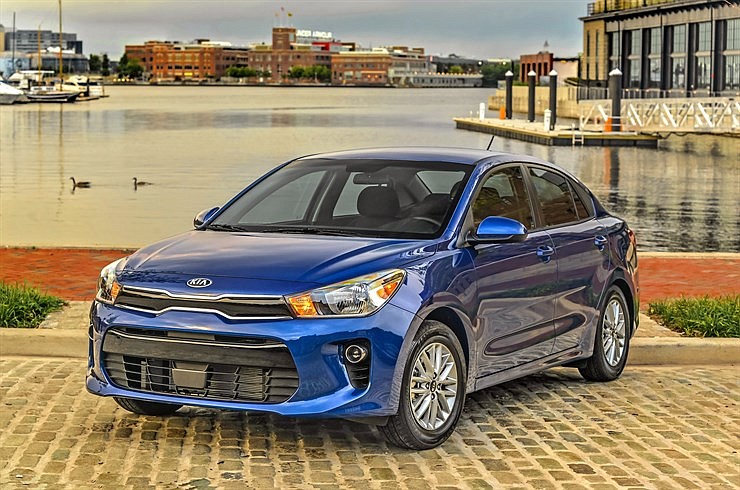Okay, Kia, this is progress.
When Kia first introduced the Rio to the United States in 2000, I was less than gracious, using a simile that finished, "like a beer can on wheels."
Things have changed. The Rio has gained a reputation as a value leader in subcompact cars and has grown into Kia's largest world-wide seller, more popular abroad than here, the land of pickups, SUVs and cheap gas.
Now comes the fourth generation, and the all-new 2018 Rio is simply a great little car.
Starting at $14,165 and topping out at less than $21,000, the new Rio is peppy, quiet, modestly roomy, well-mannered in ride and well-planted in handling. It runs near the head of a pack that includes the Honda Fit, Chevy Sonic, Ford Fiesta, Mini Cooper, Toyota Yaris iA and the Hyundai Accent: Good picks all if your goal is affordable in-town transportation that comfortable, even enjoyable, on a road trip.
Tight chassis, spry engine
Mechanicals are what make the car. While the Rio does not do anything to boggle the mind with its sophistication, it excels at the basics: strong engine, smooth transmission, and an advanced platform to employ advances in metallurgy and engineering.
The fourth generation Rio is longer and wider than predecessors, and the new chassis is 30 percent more rigid for improved handling and ride. For reduced noise, vibration and harshness, the Rio uses body sealing and bonding adhesives to dampen sound pathways throughout its construction.
The net result is a car that resists noise and smooths out road imperfections. It runs smoothly on the interstates, yet eagerly tackles two-lane back roads. This is not an "Ohmigosh, I can't wait to get on the track" machine; rather it is a car that handles normal, everyday driving with the quiet and calm responsiveness more often found in cars costing twice as much.
The same can be said of the one and only engine available, a pleasant, smooth and torquey 1.6-liter four-cylinder engine that provides improved fuel efficiency, better responsiveness and spot-on, low-speed driving dynamics.
The new engine features a high-pressure fuel system with direct injection, variable intake system, low-friction oil seals, and piston cooling-jets. An aluminum valve cover and block reduce weight, while cast iron linings increase durability.
It puts out 130 hp and 119 lb.-feet of torque. It is one of the strongest engines in the segment and has more than enough power to merge smoothly into interstate traffic, even as fast as it runs in these parts. Top end, according to independent testing, is 115 mph, and we saw no reason to test that.
The engine is growly at the upper end of the tach, but so are almost all the engines in this segment; the Cooper Mini is the lone exception.
The new Rio is estimated to attain 28 mpg highway/ 37 city/ 32 combined, which is on par with the best of segment. Our actual numbers did not significantly differ from the EPA's estimates.
Comfy cabin
We recently spent time behind the wheels of cars that are not at the top of this class, and the first thing to catch our attention was the roominess and comfort of the Rio interior. Plastics dominate the interior materials, but not the cheap kind.
To the touch, the car seems more expensive than it is. Surfaces have a pleasant feel and are tightly aligned.
Seats are comfortable and provide ample head- and leg-room. With an available tilt-and-telescoping steering wheel, it is easy to find a comfortable driving position. Like every other car in its class, the Rio offers minimal back-seat legroom.
The Rio is offered in either hatchback or sedan. For carrying things, the hatch is the far better choice. The sedan has 13.7 cubic feet of trunk space. The hatchback has 15 cubes in the trunk, and 49.8 when the seats are folded, about as good as it gets in the world of subcompacts.
No navigation system is available. In the interest of keeping sticker prices down, Kia decided to do what millions across the planet do, use the telephone. Integrated into the infotainment system are Apple CarPlayTM1 and Android AutoTM2
Safety
If this were two years ago, the Rio would be a safety all-star. Though complete testing data is not yet available, Kia engineers designed it to attain Insurance Institute for Highway Safety (IIHS) Top Safety Pick designation and a 5-star rating from the National Highway Traffic Safety Administration (NHTSA).
Standard safety features include six airbags, side-impact door beams, electronic stability control, a four-wheel anti-lock brakes, hill-start assist and vehicle stability management.
What it lacks is a complete suite of driver assist technologies, like blind-spot monitoring, lane-keep assist and dynamic cruise control.
Autonomous emergency braking is standard on EX, the top trim line, which is also the only one with rear disc brakes.
Kias come with one of the best warranties: a five-year/60,000-mile basic warranty and a 10-year/100,000-mile powertrain warranty.



